In Water Draining Methods
There are times where it may be to your advantage to try to empty the water from your kayak while you are still in the water. If you don't have a pump and you are alone this may be a necessity. If you just don't like pumping out water, then these options may be to your liking.
A word of caution for these in water draining methods, never risk longer exposure time to drain the water if you are not properly dressed for immersion. Also, practice these skills before you need them to see if they are an option for you and your equipment. These may be perfect examples of equipment or body specific skills.
Your ultimate goal is to save pumping time and the energy it takes to pump out water. If you are exhausting yourself trying these in water draining options then you may wish to redirect your efforts.
The bow lift is one of the basic options. You can use your paddle float when it is on the paddle and put the paddle shaft under your armpit with the float close to your body. When ready, do strong scissors kicks and lift the bow. You may need to bounce the kayak to break the seal at the cockpit coaming.
Once the bow is lifted hold it up as long as you can to drain more water. When ready try to spin the kayak right side up. Some kayaks spin up automatically.
Strength and arm length are a great asset but I have a 5 ft tall friend who can do this with just a quick lift and flip with her kayak.
There are some kayaks I cannot lift by the nature of their design. There are other kayaks I can lift without the use of the float thanks to their design and my longer arms and strength. It is very difficult or impossible to do this with a loaded kayak or a kayak without a rear bulkhead.
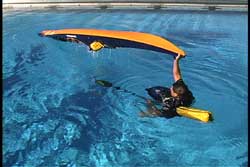
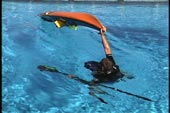
The opposite of a bow lift is the stern drop. This is where it pays to have some body weight. The idea is to jump up on the stern with the goal of the bow popping up. If the stern drops enough the cockpit will drain.
When ready roll the kayak upright trying not to scoop any additional water with the cockpit. Be careful if you have a rudder. I have seen people get slapped in the face with their rudder when the kayak flipped up.
I know a lot of paddlers who have tried this skill and their kayak never lifted up. Between their body weight and kayak design this was not a viable option.
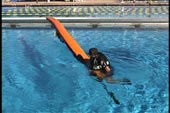
If you are not alone and you have another kayak nearby you can use the other kayak for support while you lift to do the drains. You can also slide the bow over the other kayak so not much lifting is needed, just enough to get the bow on the other kayak.
If it is a traditional all in recovery you can slide the bow over the hull of the other overturned kayak. You can slide it over the mid section or the bow of the second kayak.
If your partner is unable to help with the drain, you can hang on the bow of their upright kayak and do your own drain. Perhaps your partner lacks the strength or they are busy doing something else. Maybe two out of three kayaks went over. Your partner is draining one and you are out of the way by their bow helping yourself rather than waiting for your partner to finish.
These same methods can be used on any type of floating or solid support. Perhaps it is a dock, a buoy, a reef, a jetty, a drift wood log, a surfacing submarine, Moby Dick, etc... Just be aware of the wave action when approaching other objects.
The message is, take advantage of your surroundings when possible.
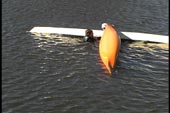
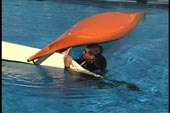
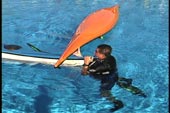
If you cannot do the in water drains or don't have the time for them, then try to scoop as little water as possible when righting your kayak. The less water in your kayak the shorter the pumping time.
One way to minimize the scooping action of the cockpit is getting under the kayak when it is overturned. Surface inside your cockpit with one hand on either side of your coaming. You can breathe the air in your cockpit as long as the cockpit is not completely filled with water. Most cockpits don't fill very much when the kayak first capsizes.
When ready thrust the kayak up and over. Very little water remains in the cockpit with this technique.
When all else fails, get to the side of you cockpit and do the fastest flip you can by pushing up on one side of your coaming. Do NOT jump on your overturned kayak and fall over with it to try and right it. You will scoop lots of water which leads to more pumping time.
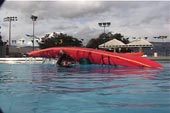
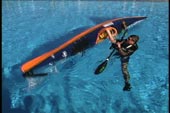
As I mentioned earlier, there may be times when you cannot pump or prefer not to pump water from your kayak after a capsize and wet exit. The options mentioned above can provide you with some possible alternatives.
I have found some of these skills very equipment specific and some body specific. The only way you will know if you can do them is by trying them out. Remember to try skills out before you really need them.
Pictures seen above were taken from the USK Video "Capsize Recoveries & Rescue Procedures"
© Copyright USK